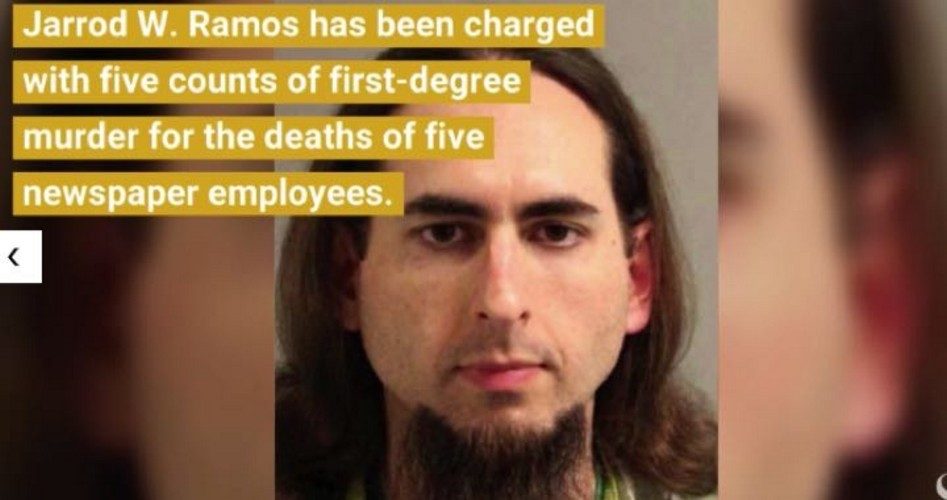
When Jarrod Ramos blasted his way through the front glass door of the offices of the Capital Gazette newspaper in Annapolis, Maryland, Thursday afternoon and started shooting, journalists working there dove for cover. They hid behind desks and curled up in corners so as not to be seen, holding their breaths, hoping to avoid being shot.
It took 60 seconds for armed police to arrive to subdue the shooter, but by then it was too late: Five people were killed and two others injured before he was neutralized. Phil Davis, the paper’s courts and crime reporter, explained his feelings:
I’m a police reporter. I write about this stuff … all the time. But as much as I’m going to try to articulate how traumatizing it is to be hiding under your desk, you don’t know until you’re there and you feel helpless.
He added:
There is nothing more terrifying than hearing multiple people get shot while you’re under your desk, and then hear[ing] the gunman reload.
Reporter Selene San Felice took a more active approach: She used her iPhone to text her parents to tell them that she loved them.
“When seconds count, the police are minutes away” goes the proverb. Even though the police were just 60 seconds away, it was more than enough time for the shooter to end the lives of Rob Hiassen, 59, the paper’s assistant managing editor; Gerald Fischman, editorial page editor; Wendi Winters, a features reporter; reporter John McNamara; and sales assistant Rebecca Smith. If the shooter, who had been nursing a grudge ever since the paper reported back in 2011 about a harassment case in which he pled guilty, was seeking the two responsible, they weren’t there. The columnist who wrote the original article, Eric Hartley, doesn’t work for the Capital Gazette any longer, and Thomas Marquardt, the paper’s former editor and publisher, had retired to Florida years earlier.
Media coverage focused on the motives of Ramos, calling him “recalcitrant,” angry, and uncooperative under questioning by the police. They learned that, since losing his lawsuit in 2015, Ramos had continued a long series of attacks on the paper on social media, often expressing his anger through obscenities and threats. When asked about Ramos, Marquardt said that he feared that he might be a threat to the paper, and even considered filing a restraining order against him, but ultimately decided not to.
Media reported that Ramos is being charged with murder in the first degree, as police stated that he had carefully planned the attack in advance. Bail was denied on Friday.
What the media isn’t reporting is why the journalists working Thursday afternoon at the newspaper had no means to defend themselves. Not a single one took the time to search for the real culprit: Maryland legislators who, not being bound by the state’s constitution with any protection to its citizens to own firearms (there is none), have taken it upon themselves to make it virtually impossible for anyone to obtain a concealed carry permit. Just 15,000 of the state’s six million citizens have succeeded in persuading local authorities, operating under “may issue” guidelines (instead of “shall issue” orders) to obtain one. These restrictions not only keep locals from obtaining permits but significant proof exists that police harass visitors to the state who carry concealed, thinking that their own state’s permission also applies to Maryland. They do not.
Wikipedia notes the problem: “Maryland is a ‘may issue’ state for concealed carry. Applicants must demonstrate a ‘good and substantial reason’ to carry a handgun. Permits are normally very difficult for ordinary citizens to obtain.” Once obtained, the permits must be renewed annually, providing continuing proof of the citizen’s “good and substantial reason” to carry. Personal protection against deranged and angry shooters such as Ramos is not a sufficient “good and substantial reason,” and so the journalists on Thursday were left with just desks and iPhones to defend themselves with.
Had they been allowed to exercise their Second Amendment rights (missing as noted above from the state’s constitution), the police, arriving 60 seconds too late, would have found themselves performing forensics on the likely deceased shooter and giving post-shooting interviews to most if not all of those who died on Thursday.
Image: Screenshot from a video produced by the Baltimore Sun
An Ivy League graduate and former investment advisor, Bob is a regular contributor to The New American magazine and blogs frequently at LightFromTheRight.com, primarily on economics and politics. He can be reached at [email protected].



